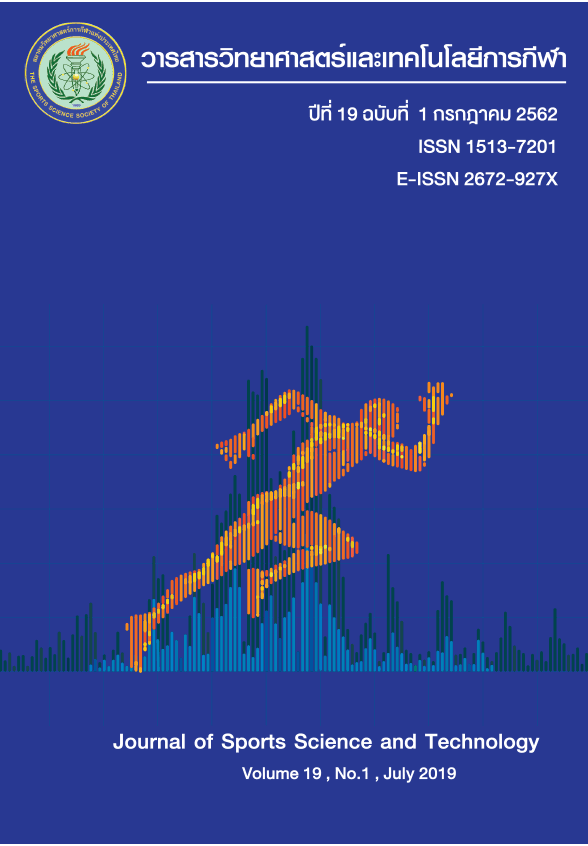Changes in Performance of Professional Thai Boxers after Six-weeks Training
Keywords:
Force / Velocity/ Roundhouse kick / Muscle training program / Thai boxingAbstract
The purpose of this research was to study the effects of the muscle training programs before and after training on force, velocity in roundhouse kick, reaction time, and muscle performance in Thai boxing. Twelve
professional Thai boxers participated in this six weeks studying period. At the period of this study, they were
being trained by the same coach under the similar protocol. The participants were randomly divided into a
control group (n=6) and an experimental group (n=6). Apart from their routine training programs, participants in the control group practiced with their routine program of Thai boxing six days a week (Monday to Saturday). The experimental group was additionally trained for strength endurance program and speedstrength of the abdominal muscles and quadriceps muscles three days a week (Monday, Wednesday, and Friday) for six weeks. Data were analyzed using t –test (Independent t-test, Paired sample t-test).The result showed that after six weeks training, force velocity of the middle roundhouse kick, reaction time, muscle strength, and muscle power of the experimental group were significantly higher than those of control group. It is documented from the present study that the minimal period of six weeks is enough to enhance performance of boxers. Effects of the additional training during the Thai boxing to be further
investigated.
(Journal of Sports Science and Technology 2019; 19(1): 120-132)
(Received: 7 March 2019, Revised: 10 May 2019, Accepted: 17 May 2019)
KEYWORDS: Force / Velocity/ Roundhouse kick / Muscle training program / Thai boxing
*Corresponding author: Onemai PRAPHANBUNDIT
Faculty of Sports Science, Burapa University
Bangsaen, Chonburi, Thailand 20000
onemaiday@gmail.com
References
SAWANGKAWAT S. Bangkok: Grand Prix international; 1985: 100-7.
2. Kantamara K. Mae Mai Muay Tai the Art of Self-Defense; Issue 2 Language.. Bangkok:
Chulalongkorn University; 2010.
3. Kraitus P, Kraitus P. MuayThai. Bangkok: Asia Books; 1988.
4. Chentanez T, Chentanez W. Amateur boxer fitness training. Bulletin of Sports science and
technology.1999; 9:43-6.
5. Borawski, B. Kicking. The Journal Crossfit Article Reprint. 2007; 57:1-4.
6. Sidthilaw S. Kinetic and Kinematic Analysis of Thai Boxing Roundhouse Kicks. 1997.
Doctor of Philosophy in human performance. Oregon State University.
7. Office of the Higher Education Commission, College of Sports Science and Technology, Mahidol
University. The physical fitness norms of Thai university athletes. Bangkok : Media Press; 2017.
8. Kamutsri T. Treeraj A, Sriwilai C, Nabsanit J. The physical fitness norms of Thai university athletes.
College of Sports Science and Technology, Mahidol University; 2015.
9. Sriramatr S. Principles of sports training for sports coach. Fifth ed. Bangkok: Chulalongkorn
University; 2016.
10. Kasidet K Srichaisawat P, Muangnapoe P. The Effect of Plyometrics Training on Diagonal
Roundhouse Kick (Tae Chieng) Ability of Muaythai Boxers. Journal of Faculty of Physical
Education, 2010; 13(1): 8-17.
11. Krabuanrat C. Principles of physical fitness for athletes. In physical fitness test for athletes.
Bangkok: Newthaimitrakarnpim. 1999: 28-38.
12. Mathews, P. Sample Size Calculations: Practical Methods for Engineers and Scientists. Harbor:
Mathews Malnar and Bailey; 2010.
13. Gavagan, C. J., & Sayers, M. G. L. A biomechanical analysis of the roundhouse kicking technique
of expert practitioners: A comparison between the martial arts disciplines of MuayThai, Karate,
and Taekwondo. PLoS One. 2017; 12(8).
14. Kim, H. Y., Kim, H. Y., & Im, J. S. Inter-joint coordination in producing kicking velocity of Taekwondo
kicks. J Sports Sci Med. 2011; 10(1): 31–8.
15. Diniz, R., Del Vecchio, F. B., Schaun, G. Z., Oliveira, H. B., Portella, E. G., da Silva, E. S., & Pinto,
S. ( 2018) . Kinematic comparison of the roundhouse kick between Taekwondo, Karate, and
MuayThai. J Strength Cond Res. 2018; 25.
16. Luk, T. C., & Hong, Y. Comparison of electromyography activity between different Types of
taekwondo round-house kick. In Proceeding in 18 international symposium on biomechanics in
sports. 2000. Hong Kong, China.
17. O’Sullivan, D., Chung, C., Lee, K., Kim, E., Kang, S., Kim, T., & Shin, I. Measurement and
comparison of Taekwondo and Yongmudo turning kick impact force for two target heights. J
Sports Sci Med. 2009; 8:13-6.
18. Chainok, P, Ingkatecha, O. Biomechanical measurement and comparison of Three taekwondo
kicking in Thai Taekwondo athletes. Faculty of Sport Science Burapa university. Chonburi. 2012.
19. Kamutsri T. Physical fitness conditioning. Bangkok : Media Press; 2017.
20. Pawinee Piyachaturawat. Skeletal muscle adaptation to training. In the Lecture document for
sports science workshop, On Sports science development to prepare for the 21st century; 1999
August 2-6; Department of Physical Education, Ministry of Education. Bangkok: Bangkok Blog;
1999: p. 248-60.
21. Haddad M. Performance Optimization in Taekwondo: From Laboratory to Field. Foster: OMICS
Group eBooks; 2015.





